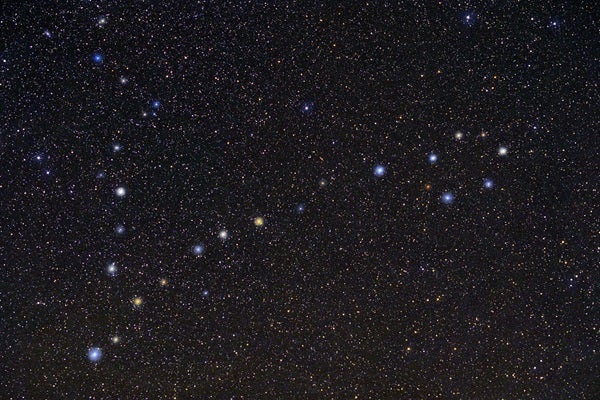Last month, I spotlighted entries 11 through 20 in the Struve catalog of double stars. It was a follow-up to an October 2014 article in which I wrote about Wilhelm Struve, the catalog of double stars he compiled in the 1820s, and the first 10 Struve pairs. His catalog remains a favorite of double-star observers because many of its pairs can be viewed through common backyard telescopes (I’ve split one-third of them with a 3-inch f/10 reflector).
Will an article on Struve 21 through 30 be a future offering? I’m afraid not — there are more than 3,100 Struve doubles, and it would take me 25 years to cover them all! Instead, I encourage you to put together your own list of Struve double stars using the Washington Double Star Catalog (WDS), which is accessible online at ad.usno.navy.mil/wds. To get data on the first 20 Struve pairs, I scrolled down the WDS and stopped at any entry identified with “STF” (the WDS code for a Struve double). I then highlighted and copied the row and pasted it into a Word document.
To pave the way to creating your own 21–30 list (or the rest of the Struve catalog if you have lots of time), let’s analyze the complete entry for Struve 21 as it appears in the WDS: 00174+0221STF 21 1902 2010 19 51 52 7.6 7.7 10.31 10.6 G0 +013+050 +014+049 +01 34 NV 001721.25+022050.6
OK, that’s a lot of numbers. But we can eliminate the final two rows, which include information on proper motion, the Durchmusterung (DM) number — don’t worry, we won’t need it — notes, and a precise position. The remaining (top two) rows begin with the right ascension and declination (in epoch 2000.0 coordinates), then the catalog identification STF 21. At a right ascension of 0h17.4m and a declination of +2°21′, Struve 21 lies in southern Pisces near its border with Cetus.
The next two figures, 1902 and 2010, give the years of the first and most recent acceptable measures of Struve 21, and are followed by a number (19) that indicates the number of measurements made during that period. We’ll keep them for now. The meat-and-potatoes data begin with 51 and 52, which refer to the position angle of Struve 21 in 1902 and 2010, respectively. The 7.6 and 7.7 are the separations (in arcseconds) in those years.
Comparing the earliest with the most recent measurements tells us that the component stars are relatively fixed. It’s been six years since the latest measure, but with this double’s slow motion, we can expect STF 21 to appear about the same tonight as it did then. The numbers 1902, 2010, 19, 51, and 7.6 are now extraneous, so we’ll remove them, leaving us with just the most recently measured position angle and separation.
The magnitudes of the component stars, which are 10.31 for the primary star and 10.6 for the secondary, complete our run of pertinent data. As Struve doubles go, this one is relatively faint. For a satisfactory view, I’d use a scope with at least a 5-inch aperture and a magnifying power no less than 150x.
A final (and optional) piece of information is the spectral class — typically given for just the primary star. A spectral class of G0 means it should shine with an off-yellow hue, but at 10th magnitude, the color may not be obvious. For that reason, we’ll omit the spectral class.
After some tweaking and rearranging of the remaining data, we get (drum roll): STF 21 0h17.4m +02°21′ 10.31+10.6 7.7″ 52°
Now we can scroll on to STF 22 and repeat the process.
Struve’s 3,100-plus pairs aren’t the only game in town. The WDS includes data for more than 100,000 double, triple, and multiple stars from dozens of catalogs. I like to scroll through the entries looking for new doubles to observe. You can try it yourself. To target pairs appropriate for your scope, key in on the magnitudes of the component stars, their separations, and finally the declination. Observers at mid-northern latitudes, like me, will want to bypass anything below –40°. Doubles here will either be obscured by atmospheric turbulence or lie below the southern horizon.
Let me conclude with a word to all you double-star fanatics who are concerned that I’m cutting loose the remainder of the Struve catalog. I’m not completely abandoning double stars — no way! Their sheer numbers and unique beauty can’t be ignored. As I always say, “Double stars are twice the fun!”
Questions, comments, or suggestions? Email me at gchaple@hotmail.com. Next month: Start the year with 10 cosmic picks. Clear skies!











